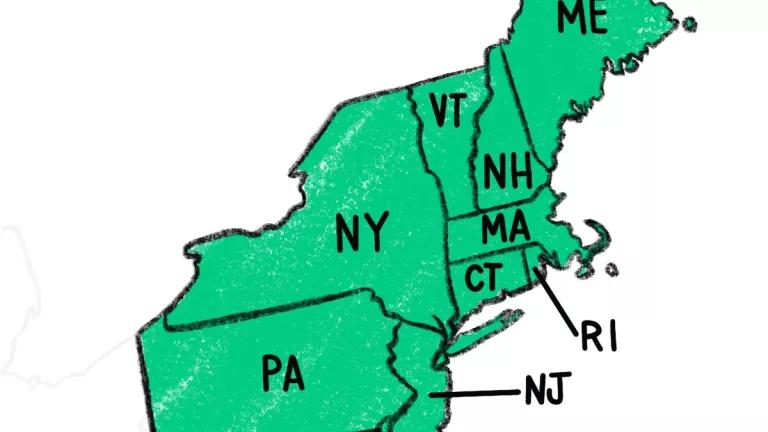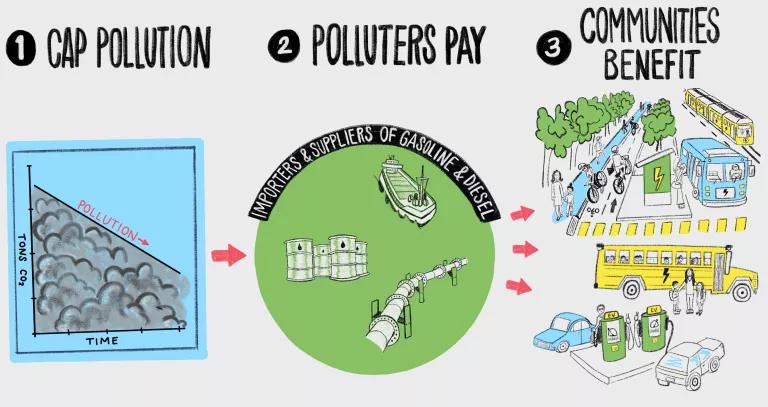Eastern States’ Clean Transportation Plan Takes Shape
A coalition of 12 Northeast and Mid-Atlantic states and Washington, D.C. is proposing a bold plan to slash pollution from the region’s cars and trucks.

Jessica Russo, NRDC
To solve the climate crisis, we need bold leadership across the economy, especially in transportation, which is the United States’ number one source of climate pollution. Unfortunately, the Trump administration is heading in reverse by protecting polluters over people and pushing costly and dirty vehicles that make us sick. That’s why today's announcement from a coalition of 12 Northeast and Mid-Atlantic states and Washington, D.C., outlining a state-led plan to slash pollution from the region’s cars and trucks, is so important.
Now this coalition must follow through with a rock-solid commitment to cut harmful transportation pollution at the scale needed to avert the climate crisis, charge polluters for the pollution they create, and steer proceeds to cleaner transportation options for rural, suburban and urban communities.
The coalition of states, known as the Transportation and Climate Initiative or TCI, extends from Virginia to Maine, and has been working for two years to develop a regional policy to provide better, cleaner transportation options for residents of urban, suburban, and rural areas. Such a policy would improve public transit, ensure streets are walkable and bikeable, and deploy clean electric vehicles to make our communities healthier and more livable.
After a year-long process of listening to stakeholders in 2018, the TCI states have spent 2019 exploring policy options—while continuing to solicit input from stakeholders and other experts—and are now nearing a policy proposal by the end of the year.
What the States are Proposing
In a series of public listening sessions last year, the TCI states heard overwhelmingly that Northeast and Mid-Atlantic residents want access to clean transportation options and a regional plan to deploy them. Today’s announcement explains how the states will follow through.

Under the proposed policy, suppliers of fossil fuels will be required to both cut and pay for their pollution. States will invest these payments in clean transportation solutions that benefit communities.
Image: Jessica Russo, NRDC
The announcement includes the following details:
- The states will publish a draft regional clean transportation policy by the end of 2019 and finalize this proposal in 2020. Today’s framework is a high-level look at the policy under development, which the states will further develop in the coming weeks. Following additional opportunities for stakeholder input, the states will issue a final proposal in 2020. States will then need to adopt this proposal under their state laws. Leaving time for this process, the policy could take effect as early as 2022.
- The TCI policy will build on an existing, highly-successful approach that’s already cutting carbon pollution in the power sector. Known as cap-and-invest, this approach has helped cut pollution from power plants in most of the TCI region in half over the last decade, lowered energy bills, spurred billions of dollars in consumer-saving clean energy investments like renewable energy and energy efficiency, and generated billions more in public health benefits from cleaner air. Applied to transportation, we can expect similar benefits, including increased investments in the clean transportation solutions the public demands.
- Importantly, TCI states are committing not just to replicate this existing policy model, but to improve it. This includes ensuring that clean transportation solutions enhance equity, including by providing benefits to communities most burdened by pollution and underserved by our current transportation system. The states are committing to work directly with disadvantaged communities to participate in and shape transportation solutions both under the regional policy and other complementary policies needed to reduce emissions and improve transportation outcomes.
- The first target for cleaning up transportation will be the fossil fuels used in on-road vehicles, including cars, trucks, and buses, which account for the lion’s share of transportation carbon pollution—more than 80 percent. To cut these emissions, the states will require large suppliers of polluting fuels like gasoline and diesel to both reduce pollution and pay for the pollution they cause. Proceeds raised under the policy will be invested in clean transportation solutions throughout the region.
- While this policy will establish a common regional framework, it won’t be the only clean transportation initiative. Cities and states will also continue to pursue other strategies, including complementary investments in public transportation and clean vehicles. They will also continue to push back against the Trump Administration’s reckless efforts to keep dirty vehicles on our roads, as will NRDC. In states that have made economy-wide climate commitments, like New York, the TCI policy will work alongside additional strategies to achieve these laws, subject to and consistent with state requirements to ensure ambitious emissions reductions and benefits to disadvantaged communities.
It’s Time to Seize This Opportunity
The proposed TCI policy is a huge opportunity, though key details must still be worked out.
Critically, the states have yet to identify the cap or overall limit on carbon pollution the policy will require. A recent analysis from our friends at the Sierra Club found that, through a collection of strategies including a TCI policy, New York could cut on-road vehicle carbon pollution to 55 percent lower than what on-road vehicles emitted in 1990, over the next 15 years. Such ambitious reductions must be the starting point for New York and the other TCI states as they craft their final policy.
Governors and state legislators (and the mayor and city council of D.C.) must also commit to adopting and implementing this policy under state and local laws. In the coming weeks and months, TCI state leaders, starting with governors and the mayor of D.C., will have an opportunity to show their commitment by releasing an ambitious regional policy proposal that includes a strong carbon cap and announcing their intent to move forward.
We expect and urge these officials to lead. The climate crisis demands nothing less.



